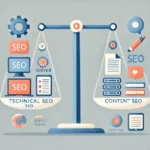In the vast world of SEO, understanding the difference between technical and on-page SEO is crucial for anyone aiming to enhance their website’s visibility and ranking. These two types of SEO are fundamental to a successful digital marketing strategy. In this article, we will explore these differences and how they impact your website’s performance.

What is SEO?
SEO, or Search Engine Optimization, is the process of optimizing your website to increase its visibility when people search for products or services related to your business in search engines like Google. The better visibility your pages have in search results, the more likely you are to garner attention and attract prospective and existing customers to your business.
Understanding Technical SEO
Technical SEO refers to optimizing your website’s infrastructure to help search engines crawl and index your site more effectively. It involves various tasks that improve the technical aspects of a website, ensuring that it meets the technical requirements of modern search engines.
Key Components of Technical SEO
- Site Speed: The faster your site loads, the better it is for user experience and search rankings.
- Mobile-Friendliness: Ensuring your site is accessible and usable on mobile devices is crucial since more people are browsing on their phones.
- XML Sitemaps: An XML sitemap helps search engines understand your site structure and find new or updated pages quickly.
- Robots.txt: This file tells search engines which pages on your site should not be crawled.
Understanding On-Page SEO
On-Page SEO involves optimizing individual web pages to rank higher and earn more relevant traffic in search engines. It includes both the content and HTML source code of a page that can be optimized.
Key Components of On-Page SEO
- Content Quality: High-quality, relevant content is key to attracting and retaining visitors.
- Title Tags: These are HTML elements that specify the title of a web page, crucial for SEO and user experience.
- Meta Descriptions: A brief description of the page content, helping search engines understand what the page is about.
- Internal Linking: Linking to other pages on your site helps search engines crawl your site and understand the relationship between different pages.
Technical SEO vs. On-Page SEO: The Key Differences
The primary difference between technical and on-page SEO lies in their focus areas. While technical SEO is concerned with the technical setup and performance of your website, on-page SEO is focused on optimizing the content and HTML of individual pages.
Impact on Search Engine Crawling
Technical SEO ensures that search engines can easily access, crawl, interpret, and index your website. It lays the foundation for a strong SEO strategy. On the other hand, on-page SEO focuses on providing search engines with the right signals through high-quality content and optimized HTML tags.
User Experience
While both types of SEO aim to improve user experience, technical SEO does so by ensuring a fast, mobile-friendly, and easy-to-navigate website. On-page SEO enhances user experience by delivering valuable, relevant content and engaging the audience with organized information.
How to Implement Technical SEO
Implementing technical SEO requires a thorough understanding of your website’s architecture and the technical aspects that need optimization. Here are a few steps to consider:
- Conduct a Technical SEO Audit: Identify issues like broken links, duplicate content, and crawl errors.
- Improve Site Speed: Compress images, leverage browser caching, and reduce server response times.
- Optimize for Mobile: Ensure your site is responsive and performs well on all devices.
- Use HTTPS: Secure your website with an SSL certificate to ensure data privacy and security.
For a detailed checklist on implementing technical SEO, you can visit this technical SEO checklist.
How to Implement On-Page SEO
Optimizing your content and HTML is essential for on-page SEO. Follow these steps to get started:
- Create High-Quality Content: Focus on providing value to your readers with informative and engaging content.
- Optimize Title Tags and Meta Descriptions: Ensure these elements are descriptive and contain relevant keywords.
- Use Header Tags: Organize your content with H1, H2, H3 tags to improve readability and SEO.
- Enhance Internal Linking: Link to other pages on your site to improve navigation and SEO.
For more information on improving your SEO through content, you might find this SEO checklist useful.
Conclusion
Understanding the difference between technical and on-page SEO is essential for anyone looking to improve their website’s performance and search rankings. While both types of SEO have distinct roles, they complement each other to ensure a comprehensive SEO strategy.
By focusing on both the technical aspects and the content of your website, you can create a powerful online presence that attracts and retains your target audience. For further insights, consider exploring the importance of SEO courses or learn about reclaiming lost backlinks.

FAQs
What is the main difference between technical and on-page SEO?
The main difference between technical and on-page SEO is their focus areas. Technical SEO focuses on the technical setup and performance of the website, whereas on-page SEO focuses on optimizing the content and HTML of individual pages.
Why is technical SEO important?
Technical SEO is important because it ensures that search engines can effectively crawl, interpret, and index your website, which is essential for improving search engine rankings.
How does on-page SEO benefit my website?
On-page SEO benefits your website by optimizing the content and HTML tags, improving search engine visibility, and enhancing user experience.







